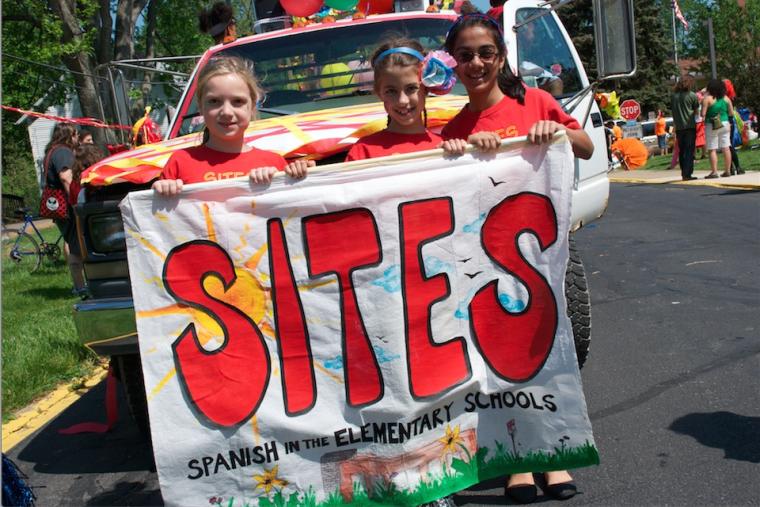SITES Set on Education
June 12, 2015
Rosalind Black

Photo credit: Kim Faber
This year marked the 10-year anniversary of the early language learning program Spanish in the Elementary Schools (Oberlin SITES), founded and run by Kim Faber, program director. To celebrate, Faber organized an education symposium, titled Language, Power, and Education, featuring a series of events and panel discussions surrounding the topic of education, simultaneously highlighting the kickoff of the new Education Studies Concentration.
While the entire symposium discussed education in various contexts, the event that honored SITES’s anniversary in particular was a panel called Alumni in Education, in which nine Oberlin College alumni of the SITES program discussed their experiences and education at Oberlin and the careers that followed. “It has been interesting to see where their lives took them,” Faber says. The panel was followed by breakout sessions and an alumni-student networking session sponsored by the Career Center that allowed current students to have smaller group discussions with an individual alum. “It was good for students to see a lineup of options. I think they appreciated that.”
The idea came to Faber during Commencement/Reunion Weekend 2014 when she was talking to SITES alumni who were visiting campus. They suggested she enlist alumni of the program to talk about education with current students, commemorating the program’s anniversary and sparking a discussion in the process.
Faber founded the SITES program after discovering that there was no language learning program in the Oberlin City Schools until the high school level. At the time, her son was entering kindergarten. To rectify the situation, she started a community-based service learning course in which students taking her Linguistics for Language Students course—already interested in teaching languages—could get college credit and teaching experience, while providing language classes to kids in the city schools. Her initial support was limited to a small grant from the Bonner Center for Service and Learning.
After surveying the community, Faber discovered that Spanish was the most popular foreign language choice. Swearing to “underpromise and overdeliver,” in 2005 Faber began training 16 college students to teach one class per week for 10 weeks each semester in four kindergarten and four third-grade classrooms at Eastwood and Prospect Elementary Schools. The next year, Faber expanded the program to include all kindergarten through fifth-grade classrooms, more than tripling the number of required college students from 16 to 54. Faber says she was worried at first that they would not get enough volunteers, but 65 students signed up. Fears assuaged, she was able to place teachers in not just elementary school classrooms but preschool classrooms as well.
SITES gives students teaching experience in all three sectors of mainstream educational philosophy: integrative learning, where students connect and combine what they have learned from multiple classes; reflective learning, where they think about and explain what they are learning and how; and active learning, where they put into practice the theories they have learned. Professor of Hispanic Studies Sebastiaan Faber says, “The unusual thing is that there are these buzzwords, but you can see from SITES how it works: Students come out of the program with a much clearer sense of how all of this hangs together, with a real practical set of skills that students don’t always have.”
Elementary school students receive 30 minutes of Spanish instruction twice a week during the school year. SITES teachers specialize their lesson plans and teaching methods for the grade they are working with that semester so that students are more engaged with what they’re learning. This means “we talk a lot about teeth and blood because their teeth are always falling out and they always have a Band-Aid on. Instantly they say, ‘I’m with you. You’re talking about me and my teeth,’” Kim Faber says, laughing.
The SITES program not only benefits elementary school students and college students aspiring to be teachers, but it has also affected the school system, allowing Oberlin City Schools to become the first K-12 International Baccalaureate (IB) district in Ohio, and paving the way for a structural integration of language teaching across all grades. Starting next year, students in first through fifth grade will be taught by a certified teacher with IB training. SITES instructors, meanwhile, will continue to teach Spanish in kindergarten, first and second grade, as they work closely with the Oberlin City Schools to support language learning at all grade levels.
“It’s been a powerful 10 years. I’m excited to see what happens next,” Kim Faber says. “I’ve learned a ton and the students have, too. It’s a safe playground. Obies love being creative and sometimes we, as educators, need to get out of their way and let them learn by doing. SITES is a really great place for that.”
You may also like…
Oberlin Opera Brings “Jack and the Beanstalk” to Schools Across Northeast Ohio for Winter Term
“It was really amazing going into the community and performing an art form that they probably haven't seen before,” second-year voice major Ella Vaugn said, “Teachers would tell us that they've never seen their students so engaged.”
Universal Languages
Kenji Anderson came to Oberlin to study English and piano—and left with a deepened love of Japan.
South-of-the-Border Second Home
Anna Sheik returns to Mexico to follow her love of language, history, and teaching.


